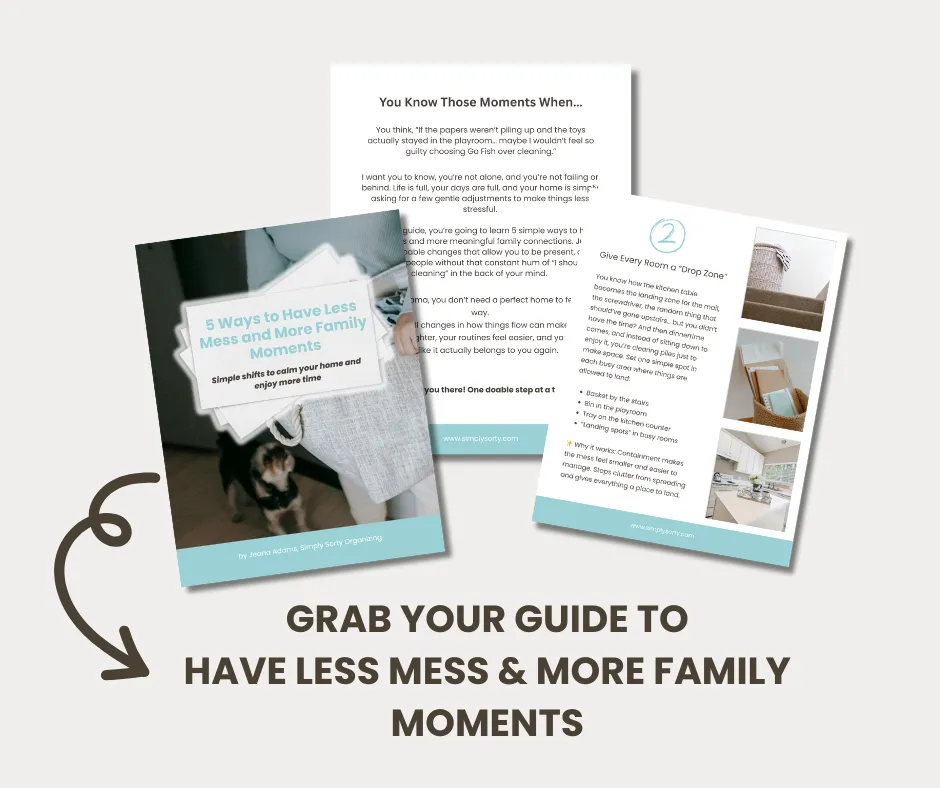
PROFESSIONAL HOME ORGANIZER SERVING New Richmond, WI | Hudson, WI | Menomonie, WI | Stillwater, MN | Twin Cities, MN

Helping Busy Moms Reclaim Their Homes
From piles of toys, mail, and half-finished projects to simple systems that support real life.
Quick interest form • No pressure
Hi, I'm Jeana!
I’m the founder of Simply Sorty Organizing, a professional home organizer in New Richmond, WI, helping busy moms create simple, functional home systems that support real life.
As a wife, mom of twins, and former veterinary professional turned business owner, I know what it’s like to juggle a busy home, demanding schedules, and everything in between. That’s why I help moms create thoughtful, easy-to-maintain spaces that truly make daily life easier — not just prettier.
My approach is rooted in empathy, trust, and real-life practicality. I believe home organization should feel supportive, not stressful, and every system should work for your routines, your family, and your season of life.
When I’m not helping clients reclaim their homes, you’ll find me traveling, kickboxing, boating, or spending time with our English Bulldog, two cats, and a flock of chickens.
Serving families throughout Western Wisconsin and the Twin Cities.

Hi, I'm Jeana!

I’m the founder of Simply Sorty Organizing, a professional home organizer in New Richmond, WI, helping busy moms create simple, functional home systems that support real life.
As a wife, mom of twins, and former veterinary professional turned business owner, I know what it’s like to juggle a busy home, demanding schedules, and everything in between. That’s why I help moms create thoughtful, easy-to-maintain spaces that truly make daily life easier — not just prettier.
My approach is rooted in empathy, trust, and real-life practicality. I believe home organization should feel supportive, not stressful, and every system should work for your routines, your family, and your season of life.
When I’m not helping clients reclaim their homes, you’ll find me traveling, kickboxing, boating, or spending time with our English Bulldog, two cats, and a flock of chickens.
Serving families throughout Western Wisconsin and the Twin Cities.
Does this sound familiar?
You’re constantly picking up toys, juggling schedules, and trying to find the counter under the clutter.
You just want to feel calm, caught up, and confident that your home isn’t another thing demanding your energy.
You’ve bought bins, watched organizing shows, and tried every system online—but nothing ever seems to stick.
If that sounds like you, we can help!
Simple 3 Step Process
Sort
We go through everything together and decide what truly belongs in your home and what doesn’t.
We also take care of donating the items you no longer need, so your home feels lighter.
Categorize
We group similar items and create intentional zones that match how your family actually uses each space.
This makes it easier to find what you need and keeps your home feeling calm and functional every day.
Systemize
We set up simple, sustainable systems with clear labels so everything (and everyone) knows where things go.
These systems are easy to maintain, helping your home stay organized long after we finish.
Ready to get started?
Spaces We Organize
pantry
garage
closets
kitchen
basement
bathroom
laundry room
office
bedrooms
Grateful Clients
“Finally back in control of my home”
"I have ADHD and suffer from the self-shaming that goes along with it. My house was out of control and I was completely overwhelmed and ashamed of it. I knew I needed help but was too embarrassed to call. Then I found Jeana. She came in without judgment and met me where I was. We worked together on my home office and kitchen, and she was terrific. I loved her ideas, and she kept me on track (not an easy task!). Another thing I love about her services is that when I decided to get rid of things, she took them with her at the end of the session—so they didn’t sit around for months. I look forward to completing the rest of my sessions this spring!"
- April C.

"From start to finish, she went above and beyond"
"I cannot recommend Jeana enough! She helped me tackle my chaotic basement, turning an overwhelming mess into a functional space. From start to finish, she went above and beyond. She visited my home beforehand to assess everything and even came by between sessions to help me figure out what containers I needed. Her expertise, encouragement, and reasonable pricing made the whole process smooth. If you’re feeling stuck with clutter, Jeana is the person to call."
- Natasha B.

"Transformed the room!"
"I was dreading cleaning and organizing my boys’ playroom and kept putting it off because of how overwhelming it felt. Jeana came in and in just a couple of sessions completely transformed the room! She did an incredible job—beyond what I could have expected. She even labeled the toy bins. The fact that I didn’t have to donate the items we no longer needed made it even better because she took everything with her to donate. I highly recommend Simply Sorty Organizing!."
- Hannah J.

Which of our 3 packages are right for you?
Transform
$2400
32 Organizer Hours
Carload of Donations Removed
Full Service Shopping & Returns
Custom Labels
Perfect For Playroom, Kitchen, Storage Areas, and/or Unpacking
Add on hourly until completion
Streamline
$1200
16 Organizer Hours
Carload of Donations Removed
Full Service Shopping & Returns
Labeled for Easy Maintenance
Perfect For Walk-In Pantry, Kids' Bedrooms & Closet, and/or Home Office
Add on hourly until completion
Simplify
$600
8 Organizer Hours
Local Donation Guide
Product Recommendations
Basic Labels Provided
Perfect For Reach-In Pantry, Small Closet or Laundry Room
Add on hourly until completion
Which of our 3 packages are right for you?
Transform
$2400
32 Organizer Hours
Carload of Donations Removed
Full Service Shopping & Returns
Custom Labels
Perfect For Playroom, Kitchen, Storage Areas, and/or Unpacking
Add on hourly until completion
Streamline
$1200
16 Organizer Hours
Carload of Donations Removed
Full Service Shopping & Returns
Labeled for Easy Maintenance
Perfect For Walk-In Pantry, Kids' Bedrooms & Closet, and/or Home Office
Add on hourly until completion
Simplify
$600
8 Organizer Hours
Local Donation Guide
Product Recommendations
Basic Labels Provided
Perfect For Reach-In Pantry, Small Closet or Laundry Room
Add on hourly until completion
Frequently Asked Questions
Do I work with you or can you do it for me?
You can choose to work alongside me, learning the process as we go, or simply let me take the lead while you focus on your life. The only things you’ll need to be involved in are the decision-making and decluttering choices, since those are personal to you. Either way, you’ll end up with a calm, functional space that truly works for you.
What if I feel too overwhelmed to even start?
You don’t need to have it all together to begin — you just need to take the first step. I’ll help you break the chaos into small, realistic wins that give you quick relief and momentum. Before long, you’ll go from “I can’t do this” to “I can’t believe how good this feels.
My spouse doesn’t see the clutter as a problem — how can I get them on board?
That’s so common. Many partners see clutter differently, which can cause tension. Instead of pushing them, I’ll help you create simple systems that work for everyone. When your home runs smoother and stress drops, your spouse naturally notices the difference — and often becomes your biggest supporter once they feel the calm, too.
What if my house is too far gone or I’m embarrassed?
You are not alone — most moms I work with start exactly where you are. I’ve seen it all, and there’s zero judgment here. Together, we’ll break the overwhelm into bite-sized wins and get you feeling proud of your space again.

PROFESSIONAL HOME ORGANIZER SERVING
New Richmond, WI | Hudson, WI | Menomonie, WI | Stillwater, MN | Twin Cities, MN
Simply Sorty Organizing | 651-300-2475 | [email protected]
